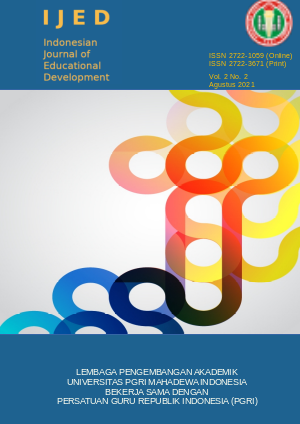Meningkatkan motivasi berprestasi siswa melalui model pembelajaran kooperatif dengan pendekatan CTL
DOI:
https://doi.org/10.5281/zenodo.5257412Keywords:
Achievement motivation, Coopertative, contextual teaching and learningAbstract
Penelitian tindakan kelas ini bertujuan untuk meningkatkan motivasi siswa berprestasi siswa melalui model pembelajaran kooperatif dengan pendekatan Contextual Teaching and Learning (CTL). Subjek penelitian adalah siswa Kelas XI MIPA 1 MAN 2 Hulu Sungai Tengah semester ganjil tahun pelajaran 2017/2018. Sedangkan objek penelitian adalah motivasi berprestasi siswa dalam pembelajaran fisika. Metode pengumpulan data berupa tes, observasi, angket. Sedangkan teknik analisis data secara deskriptif. Kriteria keberhasilan adalah motivasi berprestasi siswa tergolong baik dan ketuntasan secara klasikal 85%. Hasil penelitian menunjukkan adanya: 1) motivasi berprestasi siswa pada siklus I dengan rata-rata 3,41 dalam kategori cukup baik, siklus II dengan rata-rata 3,51 dalam kategori baik, dan siklus III dengan rata-rata 3,63 dalam kategori baik, 2) ketuntasan belajar siswa secara klasikal pada siklus I sebesar 58,06%, siklus II sebesar 62,07%, dan siklus III sebesar 87,10%. Secara keseluruhan keterampilan kooperatif dan respon minat siswa terhadap model pembelajaran dan cara guru mengajar adalah cukup baik. Diperoleh simpulan bahwa melalui model pembelajaran kooperatif dengan pendekatan Contextual Teaching and Learning (CTL) dapat meningkatkan motivasi berprestasi siswa.
This classroom action research aims to increase student achievement motivation through cooperative learning model with Contextual Teaching and Learning (CTL) approach. The research subjects were students of Class XI MIPA 1 MAN 2 Hulu Sungai Tengah in the odd semester of the 2017/2018 academic year. While the object of research is student achievement motivation in learning physics. Data collection methods in the form of tests, observations, questionnaires. While the data analysis technique is descriptive. The criteria for success are students' achievement motivation is classified as good and classical completeness is 85%. The results showed that there were: 1) students' achievement motivation in the first cycle with an average of 3.41 in the fairly good category, the second cycle with an average of 3.51 in the good category, and the third cycle with an average of 3.63 in the good category. good, 2) classical student learning completeness in the first cycle is 58.06%, the second cycle is 62.07%, and the third cycle is 87.10%. Overall cooperative skills and student interest responses to the learning model and the way the teacher teaches are quite good. It was concluded that the cooperative learning model with the Contextual Teaching and Learning (CTL) approach could increase students' achievement motivation.
Downloads
References
Adisusilo, S. J. R. 2012. Pembelajaran nilai-karakter. Rajawali Pers.
Asiyah, A., Walid, A., & Kusumah, R. G. (2019). Pengaruh rasa percaya diri terhadap motivasi berprestasi siswa pada mata pelajaran IPA. Scholaria: Jurnal Pendidikan Dan Kebudayaan, 9(3), 217-226. https://doi.org/10.24246/j.js.2019.v9.i3.p217-226.
Aspriyani, R. (2017). Pengaruh motivasi berprestasi siswa terhadap kemampuan pemecahan masalah matematis. JPPM (Jurnal Penelitian dan Pembelajaran Matematika), 10(1), 17-23. http://dx.doi.org/10.30870/jppm.v10i1.1194.
Catrining, L., dan Widana, I. W. (2018). Pengaruh pendekatan pembelajaran realistic mathematics education terhadap minat dan hasil belajar matematika. Emasains, 7(2), 120-129. ISSN 2302-2124.
Hakim, S., A. & Syofyan, H. (2017). Pengaruh model pembelajaran kooperatif tipe teams games tournament (TGT) terhadap motivasi belajar IPA di kelas IV SDN Kelapa Dua 06 Pagi Jakarta Barat. International Journal of Elementary Education, 1(4), 249-263. http://dx.doi.org/10.23887/ijee.v1i4.12966
Madsen, A., McKagan, S. B., & Sayre, E. C. (2015). How physics instruction impacts students' beliefs about learning physics: A meta-analysis of 24 studies. Physical Review Special Topics - Physics Education Research, 11(1). https://doi.org/10.1103/PhysRevSTPER.11.010115.
Mayudana, I. K. Y & Sukendra, I. K. (2020). Analisis kebijakan penyederhanaan RPP (Surat Edaran Menteri Pendidikan Dan Kebudayaan Nomor 14 Tahun 2019). IJED (Indonesian Journal of Educational Development), 1(1), 62-70. https://doi.org/10.5281/zenodo.3760682.
Merta, K. (2015). Pengaruh pendekatan pembelajaran kontekstual berbantuan media visual terhadap motivasi berprestasi dan hasil belajar IPA pada siswa kelas IV Gugus II Kecamatan Abang Kabupaten Karangasem. Jurnal Pendidikan Dasar Ganesha, 5(1), 1-12. https://www.neliti.com/publications/124316/pengaruh-pendekatan-pembelajaran-kontekstual-berbantuan-media-visual-terhadap-mo#cite.
Rosada, U. D. (2016). Strategi pembelajaran yang humanis berbasis contextual teaching and learning (CTL). Jurnal CARE Edisi Khusus Temu Ilmiah, 03(3), 21-31. http://e-journal.unipma.ac.id/index.php/JPAUD/article/view/596.
Sari, N. et al. (2018). Analisis motivasi belajar siswa dalam pembelajaran fisika sekolah menengah atas. Jurnal Pendidikan dan Kebudayaan, 3(1), 17-32. https://doi.org/10.24832/jpnk.v3i1.591.
Sepfitri, N. (2011). Pengaruh dukungan sosial terhadap motivasi berprestasi siswa MAN 6 Jakarta. Skripsi. http://repository.uinjkt.ac.id/dspace/handle/123456789/4212.
Suardi, M. (2018). Belajar dan pembelajaran. Deepublish.
Suprapto, E. (2015). Pengaruh model pembelajaran kontekstual, pembelajaran langsung dan motivasi berprestasi terhadap hasil belajar kognitif. INVOTEC, XI(1), 23-40. https://doi.org/10.17509/invotec.v11i1.4836.
Uno, H. H.B. (2016). Teori motivasi dan pengukuran analisis di bidang pendidikan (Cet. 14). Bumi Aksara.
Widana, I. W. (2020). Pengaruh pemahaman konsep asesmen HOTS terhadap kemampuan guru matematika SMA/SMK menyusun soal HOTS. Jurnal Emasains: Jurnal Edukasi Matematika dan Sains, IX(1), 66 – 75. https://doi.org/10.5281/zenodo.3743923.
Yulia, A., Juwandani, E., & Mauliddya, D. (2020). Model pembelajaran kooperatif learning. Prosidding Seminar Nasional Ilmu Pendidikan dan Multi Disiplin 3 (SNIPMD 3), 223-227. https://prosiding.esaunggul.ac.id/index.php/snip/article/view/31/36`.
Downloads
Published
How to Cite
Issue
Section
License
Copyright (c) 2021 Rita Pusparina

This work is licensed under a Creative Commons Attribution 4.0 International License.
This is an Open Access article distributed under the terms of Creative Commons Attribution 4.0 International License, which permits use, sharing, adaptation, distribution and reproduction in any medium or format, as long as you give appropriate credit to the original author(s) and the source, provide a link to the Creative Commons licence, and indicate if changes were made. The images or other third party material in this article are included in the article's Creative Commons licence, unless indicated otherwise in a credit line to the material.

















